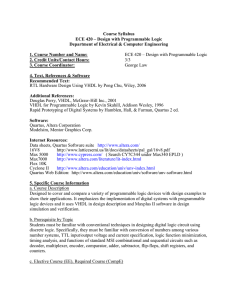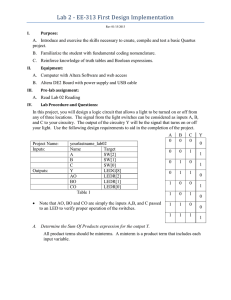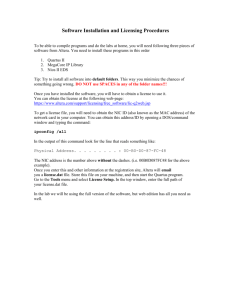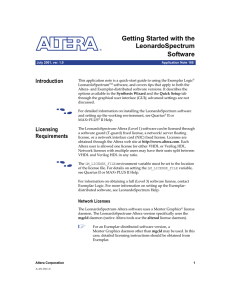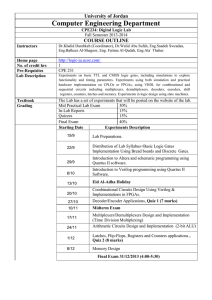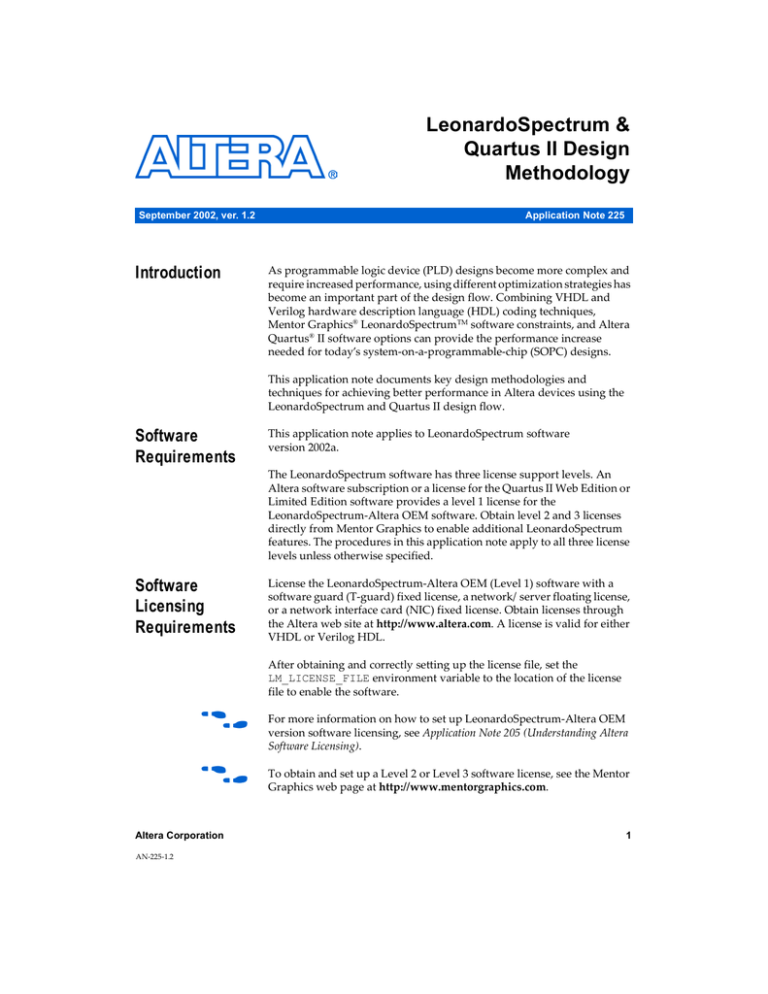
LeonardoSpectrum &
Quartus II Design
Methodology
September 2002, ver. 1.2
Introduction
Application Note 225
As programmable logic device (PLD) designs become more complex and
require increased performance, using different optimization strategies has
become an important part of the design flow. Combining VHDL and
Verilog hardware description language (HDL) coding techniques,
Mentor GraphicsR LeonardoSpectrumTM software constraints, and Altera
QuartusR II software options can provide the performance increase
needed for today’s system-on-a-programmable-chip (SOPC) designs.
This application note documents key design methodologies and
techniques for achieving better performance in Altera devices using the
LeonardoSpectrum and Quartus II design flow.
Software
Requirements
This application note applies to LeonardoSpectrum software
version 2002a.
The LeonardoSpectrum software has three license support levels. An
Altera software subscription or a license for the Quartus II Web Edition or
Limited Edition software provides a level 1 license for the
LeonardoSpectrum-Altera OEM software. Obtain level 2 and 3 licenses
directly from Mentor Graphics to enable additional LeonardoSpectrum
features. The procedures in this application note apply to all three license
levels unless otherwise specified.
Software
Licensing
Requirements
License the LeonardoSpectrum-Altera OEM (Level 1) software with a
software guard (T-guard) fixed license, a network/server floating license,
or a network interface card (NIC) fixed license. Obtain licenses through
the Altera web site at http://www.altera.com. A license is valid for either
VHDL or Verilog HDL.
After obtaining and correctly setting up the license file, set the
LM_LICENSE_FILE environment variable to the location of the license
file to enable the software.
f
For more information on how to set up LeonardoSpectrum-Altera OEM
version software licensing, see Application Note 205 (Understanding Altera
Software Licensing).
f
To obtain and set up a Level 2 or Level 3 software license, see the Mentor
Graphics web page at http://www.mentorgraphics.com.
Altera Corporation
AN-225-1.2
1
AN 225: LeonardoSpectrum & Quartus II Design Methodology
Design Flow
The basic steps in an LeonardoSpectrum-Quartus II design flow are as
follows:
1.
Create HDL design files within the LeonardoSpectrum software or a
text editor.
2.
Import the Verilog HDL or VHDL design files to the
LeonardoSpectrum software for synthesis.
3.
Select a target device and add timing constraints and compiler
directives to help optimize the design during synthesis.
4.
After completing synthesis, import the technology-specific netlist
generated by the LeonardoSpectrum software into the Quartus II
software for placement and routing, performance evaluation,
implementation, and verification in an Altera device.
Figure 1 shows the recommended design follow using the
LeonardoSpectrum and Quartus II software.
2
Altera Corporation
AN 225: LeonardoSpectrum & Quartus II Design Methodology
Figure 1. Recommended Design Flow
Altera Corporation
3
AN 225: LeonardoSpectrum & Quartus II Design Methodology
The LeonardoSpectrum software supports both VHDL and Verilog HDL
source files. With a level 3 license, it also supports mixed synthesis,
allowing a combination of VHDL and Verilog HDL source files. After
synthesis, the LeonardoSpectrum software produces several intermediate
and output files. Table 1 lists these files with a short description of each
file.
Table 1. LeonardoSpectrum Intermediate & Output Files
File Extension(s)
File Description
.xdb
Technology independent register transfer level (RTL) netlist
file that can only be read by the LeonardoSpectrum software
.v/.vh
Post-synthesis output design file in Verilog HDL/VHDL
format that you can use for post-synthesis simulation
.sdf
Timing output file in standard delay format (SDF) for timing
analysis
.edf
Technology-specific output netlist in electronic design
interchange format (EDIF)
.acf/.tcl (1)
Forward-annotated constraint file containing constraints and
assignments
Note to Table 1:
(1)
An assignment and configuration file (.acf) file is only created for ACEXTM 1K,
FLEXR 10K, FLEX 6000, FLEX 8000, MAXR 7000, MAX 9000, and MAX 3000 devices.
The .acf is generated for backward compatibility with the MAX+PLUSR II software.
A tool command language (Tcl) file (.tcl) for the Quartus II software is created for
all devices, which also contains Tcl commands to create a Quartus II project.
Specify timing constraints and compiler directives for the design in the
LeonardoSpectrum software, or in a constraint file. Many of these
constraints are forward-annotated for use by the Quartus II software in
the .tcl file. You can save all project options and included files in a
LeonardoSpectrum project file.
Import the EDIF netlist to the Quartus II software for place-and-route.
The LeonardoInsightTM Schematic Viewer is a graphical tool for schematic
views of the technology-independent RTL netlist (.xdb) and the
technology-specific gate-level result. (This schematic viewer is not
available with the level 1 LeonardoSpectrum-Altera software version.)
The LeonardoInsight Schematic Viewer is an add-on option. You can use
the Schematic Viewer to visually analyze and debug the design. The
Schematic Viewer supports cross probing between the RTL and gate-level
schematics, the design browser, and the source code in the HDL
InventorTM text editor.
4
Altera Corporation
AN 225: LeonardoSpectrum & Quartus II Design Methodology
If the area and timing requirements are satisfied, use the programming
files generated from the Quartus II software to program the Altera device.
As shown in Figure 1, if the area or timing requirements are not met,
change the constraints in the LeonardoSpectrum software and re-run the
synthesis. Repeat the process until the area and timing requirements are
met. You can also use other Quartus II software options and techniques to
meet the area and timing requirements.
Design
Planning &
Creation
Hierarchical Design Process
Use the LeonardoSpectrum software to create multiple design files and
then link them together in a hierarchy. With this structure, you simulate
and optimize the modules that comprise the design first. When following
a hierarchical design methodology, it is important to consider how the
design is partitioned. Some recommendations for partitioning designs
are as follows:
■
■
■
■
■
■
■
■
Partition the design at functional boundaries.
Minimize the I/O connections between the different partitions.
Do not use “glue logic” between hierarchical blocks. If you preserve
hierarchy boundaries, glue logic is not merged with hierarchical
blocks. The LeonardoSpectrum software optimizes glue logic
separately, which can degrade synthesis results.
Limit clocks to one per block.
Place state machines in separate hierarchy blocks to speed
optimization and provide greater control over encoding.
Separate timing-critical functions from non-timing-critical functions.
Limit the critical path to one hierarchical block. You can group the
logic from several blocks to ensure the critical path resides in one
block.
Register all inputs and/or outputs of each block. All logic is thereby
synchronous and glitches can be avoided. Also, because the outputs
are registered, this step may eliminate the need to specify the
required output times.
Top-down vs. Bottom-up Design Methodology
Most HDL-based designs use either a top-down or bottom-up (blockbased) design methodology. In top-down designs, a single optimization is
applied to the top level of the design. Thus, a top-down synthesis flow has
one output netlist for the entire design.
Altera Corporation
5
AN 225: LeonardoSpectrum & Quartus II Design Methodology
As designs become more complex, a more effective approach is an blockbased design flow. In this block-based design approach, optimization is
performed on individual sub-blocks. Therefore, each sub-block has a
separate netlist. After all the sub-blocks are optimized, the design is
integrated and final optimization is performed at the top level. Thus, each
design section is synthesized and optimized separately for a better overall
quality of results.
Table 2 describes some of the advantages of each synthesis flow.
Table 2. Top-down vs. Bottom-up Design Flow
Design Flow
Top-down
Description
One output
netlist for the
entire design
Advantages
Optimization can be performed across boundaries/hierarchy for the entire
design
Simple to manage
Bottom-up
Separate
Each module is compiled separately resulting in faster overall compilation times
(block-based) netlists for each Different optimization techniques can be applied to each module
module of the
Design modifications only require re-compilation of the affected module
design
Optimized modules can be used for other designs
Block-based Design with the Quartus II LogicLock Methodology
You can use the LogicLockTM design methodology in the Quartus II
software to perform block-based (bottom-up) compilation. The LogicLock
feature supports the designing, optimization, and locking down of design
modules. During system-level integration, the performance of each logic
module is preserved.
f
For more information on using the LogicLock feature in the Quartus II
software and the LogicLock design flow, see Application Note 161 (Using
the LogicLock Methodology in the Quartus II Design Software).
f
For specific information on using the LeonardoSpectrum software with
the Quartus II LogicLock methodology, see Application Note 164
(LeonardoSpectrum and Quartus II LogicLock Design Flow).
General
Synthesis
Design
Guidelines
6
When designing with HDL code, it is important to understand how a
synthesis tool interprets different HDL coding styles and the results to
expect. This section discusses some basic coding guidelines to provide
optimal synthesis results for Altera designs.
Altera Corporation
AN 225: LeonardoSpectrum & Quartus II Design Methodology
Combinatorial Logic
Logic is combinatorial if outputs at a specified time are a function of the
inputs at that time only, regardless of the previous state of the circuit.
Examples of combinatorial logic functions include decoders, multiplexers,
and adders. When applied to combinatorial logic, the techniques
described in the following sections help optimize the performance results
during LeonardoSpectrum synthesis.
Latches
Latches are used in digital logic design to hold the value of a signal until
a new value is assigned. Altera devices are register-intensive; therefore
designing with latches uses more logic and leads to lower performance
than designing with registers. When designing combinatorial logic, avoid
creating a latch unintentionally due to the HDL design style. For example,
when CASE or IF statements do not cover all possible input conditions,
combinatorial feedback can generate latches to hold the output in the case
when a new output value is not assigned.
Omitting the final ELSE clause or WHEN OTHERS clause from an IF or
CASE statement, respectively, can also generate a latch. “Don't care”
assignments on the default conditions tend to prevent latch generation.
Figure 2 shows sample VHDL code that prevents the unintentional
creation of a latch. If the final ELSE clause is omitted, an unintentional
latch is generated as shown in Figure 3. Figure 4 shows the schematic
representation of the VHDL code from Figure 2 that includes the final
ELSE statement, preventing the latch from being inferred.
Altera Corporation
7
AN 225: LeonardoSpectrum & Quartus II Design Methodology
Figure 2. Sample VHDL Code Preventing Unintentional Latch Creation
LIBRARY ieee;
USE IEEE.std_logic_1164.all;
ENTITY good IS
PORT
(a,b,c : IN STD_LOGIC;
sel: IN STD_LOGIC_VECTOR (1 DOWNTO 0);
oput: OUT STD_LOGIC);
END good;
ARCHITECTURE behave OF good IS
BEGIN
PROCESS (a,b,c,sel) BEGIN
IF sel = "00" THEN
oput <= a;
ELSIF sel = "01" THEN
oput <= b;
ELSIF sel = "10" THEN
oput <= c;
ELSE
-- Prevents latch inference
oput <= ’X’;
END IF;
END PROCESS;
END behave;
Figure 3. Schematic Representation of Code Unintentionally Generating a Latch
Figure 4. Schematic Representation of Code Preventing Unintentional Latch
Creation
8
Altera Corporation
AN 225: LeonardoSpectrum & Quartus II Design Methodology
Sequential Logic
Logic is sequential if the outputs at a specified time are a function of the
inputs at that time and at all preceding times. All sequential circuits must
include one or more registers (flip-flops).
Figure 5 shows sample VHDL code that prevents the unintentional
creation of feedback multiplexer. The final ESLE clause is used to assign
all states and avoid feedback. If the final ELSE clause is omitted, a
feedback multiplexer is generated, and the function requires an extra logic
element (LE) in the Altera device.
Figure 5. VHDL Code that Prevents Feedback Multiplexer Generation
LIBRARY ieee;
USE ieee.std_logic_1164.all;
ENTITY seq IS
PORT(a,b,c,d,clk,rst : IN STD_LOGIC;
sel : IN STD_LOGIC_VECTOR(3 DOWNTO 0);
oput : OUT STD_LOGIC);
END seq;
ARCHITECTURE behave OF seq IS
BEGIN
PROCESS (clk, rst) BEGIN
IF rst = ’1’ THEN
oput <= ’1’;
ELSIF clk=’1’ AND clk’event THEN
IF sel(0) = ’1’ THEN
oput <= a AND b;
ELSIF sel(1) = ’1’ THEN
oput <= b;
ELSIF sel(2) = ’1’ THEN
oput <= c;
ELSIF sel(3) = ’1’ THEN
oput <= d;
ELSE
-- Prevents feedback multiplexer
oput <= ’X’;
END IF;
END IF;
END PROCESS;
END behave;
Gated Clocks
Try to avoid using internally-generated gated clocks that use regular
routing resources because they create logic delays and clock skew, using
additional routing resources on Altera devices. Internally generated
clocks may also introduce glitches that create functional problems.
Altera Corporation
9
AN 225: LeonardoSpectrum & Quartus II Design Methodology
Altera devices include dedicated global, regional, or fast pins that feed
high-fan-out global routing lines. If necessary, you can access this global
routing for an internally-generated clock instead of an external pin.
If you must use an internally generated clock, use the dedicated global,
regional, or fast pins that feed high-fan-out global routing lines.
To implement an internally generated gated clock in a design, you can
promote the clock signal to the global line through the Quartus II
Assignment Organizer by instantiating a GLOBAL primitive.
f
For more information on using the Quartus II Assignment Organizer,
refer to the Quartus II on-line Help.
State Machine Synthesis
The LeonardoSpectrum software encodes state machines during the
synthesis process. To improve performance when coding state machines,
separate state machine logic from all arithmetic functions and data paths.
Once encoded, a design cannot be re-encoded later in the optimization
process. You must follow a particular VHDL or Verilog HDL coding style
for the LeonardoSpectrum software to identify the state machine.
Table 3 shows the state machine encoding styles supported by the
LeonardoSpectrum software.
Table 3. State Machine Encoding Styles in the LeonardoSpectrum Software
Style
10
Description
Binary
Generates state machines with the fewest possible flip-flops.
Binary state machines are useful for area-critical designs when
timing is not as much of a concern.
Gray
Generates state machines where only one flip-flop changes
during each transition. Gray-encoded state machines tend to be
glitchless.
One-hot
Generates state machines containing one flip-flop for each state.
One-hot state machines provide the best performance and
shortest clock-to-output delays. However, one-hot
implementations are usually larger than binary implementations.
Random
Generates state machines using random state machine
encoding. Only use random state machine encoding when no
other implementation achieves the desired results.
Auto (default)
Implements binary or one-hot encoding, depending on the size
of enumerated types in the state machine.
Altera Corporation
AN 225: LeonardoSpectrum & Quartus II Design Methodology
Instruct the LeonardoSpectrum software to use a particular state machine
encoding style by selecting one of the Encoding Style options above. Refer
to the “Optimization Strategies” section.
The following are recommendations when coding state machines:
■
■
■
Guidelines for
Altera
Megafunctions
& LPM
Functions
Represent the states in a state machine by defined labels/enumerated
types. This makes the state machine easier to read and reduces the
risk of errors during coding.
Assign default values to outputs derived from the state machine
before the CASE statement to avoid generation of unwanted latches
during synthesis.
Assign states to an X in the default clause of the CASE the statement
to avoid mismatches between simulation of pre- and post- synthesis
versions of the code.
Altera provides parameterizable megafunctions ranging from simple
arithmetic units, such as adders and counters, to advanced phase-locked
loop (PLL) blocks, multipliers, and memory structures. These functions
are performance optimized for Altera devices. Megafunctions include the
library of parameterized modules (LPMs), device-specific embedded
megafunctions such as PLLs and LVDS, DPS blocks, intellectual property
(IP) available as Altera MegaCore functions, and IP available through the
Altera Megafunction Partners Program (AMPP).
1
Some IP cores may be required to be synthesized in the
LeonardoSpectrum software. Please refer to the specific IP User
Guide for more information.
There are two potential methods for handling megafunctions in the
LeonardoSpectrum software; inference and instantiation. Figure 6 shows
the potential ways to use megafunctions in the Altera-LeonardoSpectrum
design methodology.
Altera Corporation
11
AN 225: LeonardoSpectrum & Quartus II Design Methodology
Figure 6. Potential Ways to Use Megafunctions
Table 4 compares the methodologies. The LeonardoSpectrum software
supports inferring some of the Altera megafunctions, such as multipliers,
DSP functions, and RAM and ROM blocks. The LeonardoSpectrum
software supports all Altera megafunctions through instantiation.
Table 4. Inference vs. Instantiation of Megafunctions
Instantiation
Advantages
Limitations
12
Inference
Most efficient use of feature in a specific
technology
Coding style allows for portability
Support for all architectural features
No tool dependencies
May not be portable
Not all megafunctions supported
Requires knowledge of Altera Megafunctions
and LPMs
Not all the features of architecture can be
inferred
Limited or no access to timing and area data
because the megafunctions are completely
black-boxed
Glue logic to implement memory and DSP
functions might result in sub-optimal
implementation
Altera Corporation
AN 225: LeonardoSpectrum & Quartus II Design Methodology
Instantiating Altera Megafunctions
There are two methods of instantiating Altera megafunctions in the
LeonardoSpectrum software. The first and least common method is to
directly instantiate the megafunction in the Verilog HDL or VHDL code.
A better approach, to maintain target technology awareness, is to use the
MegaWizard Plug-In Manager in the Quartus II software to setup and
parameterize a megafunction. The MegaWizard creates a wrapper file
that instantiates the megafunction. The benefits of using the MegaWizard
are that the all parameters are properly set and the user does not need any
synthesizer library supports as needed in the direct instantiation method.
This is referred to as the black-box methodology.
f
When directly instantiating megafunctions, refer to the Quartus II Help to
obtain a list of the ports and parameters. Generally, Altera recommends
using the Wizard to make sure the ports and parameters are set correctly.
Inferring Altera Memory Elements
The LeonardoSpectrum software can infer memory blocks from
Verilog HDL or VHDL code. When the LeonardoSpectrum software
detects a RAM or ROM from the style of the RTL code at a technologyindependent level, it then maps the element to a generic module in the
RTL database. During the technology-mapping phase of synthesis, the
LeonardoSpectrum software maps the generic module to the most
optimal primitive memory cells for the target Altera technology.
Inferring RAM
The LeonardoSpectrum software supports RAM inference for various
device families, including Stratix™ devices. Follow the guidelines below
for the LeonardoSpectrum software to successfully infer RAM in a design:
■
■
■
■
The write process must be synchronous.
The read process can be asynchronous or synchronous depending on
the target Altera architecture. (See Table 5.)
The address line must be at least 2 bits wide.
Set the extract_ram attribute to “true”. To implement in logic
elements (LEs), set extract_ram to “false.”
1
Resets on the memory are not supported.
The Stratix device family supports advanced memory features. Because of
the wide variety of functionality, the process for inferring these memory
features requires a more detailed approach than for the other device
families.
Altera Corporation
13
AN 225: LeonardoSpectrum & Quartus II Design Methodology
f
For information on Stratix memory features, refer to Application Note 203
(Using TriMatrix Embedded Blocks in Stratix Devices).
For the Stratix and Cyclone™ device families, the minimum RAM size is
2-bits and the minimum address width is 1-bit.
1
f
Altera recommends using the megafunction instead of inference
to implement RAM in Stratix devices because several of the
complex features in the Stratix architecture are difficult to infer
from HDL code.
For more information on using the LeonardoSpectrum and Stratix
memory features, contact Altera Applications.
The FLEX 10KE, APEX 20K, APEX 20KE, APEX 20KC, APEX II,
ExcaliburTM, and MercuryTM device families support both single and dualport RAM. The read address does not need to be registered, however, if it
is not registered, then the dual-port RAM is inferred. For the FLEX 10KE
and ACEX 1K devices, the minimum size is 128-bits and minimum
address width is 5-bits. For the APEX 20K, APEX 20KE, APEX 20KC,
APEX II, Excalibur, and Mercury device families, the minimum size is 64bits and the minimum address width is 4-bits.
Table 5 shows a summary of the information for inferring RAM for the
Stratix, Cyclone, APEX 20K, APEX 20KE, APEX 20KC, APEX II, Excalibur,
Mercury, FLEX 10KE, and ACEX 1K, device families.
Table 5. Inferring RAM Summary
Stratix / Cyclone
APEX 20K / APEX 20KE / APEX 20K / APEX II /
Excalibur / Mercury
FLEX 10KE /
ACEX 1K
RAM primitive
ALTSYNCRAM
ALTDPRAM
ALTDPRAM
Minimum RAM size
2-bits
64-bits
128-bits
Minimum address
width
1-bit
4-bits
5-bits
14
Altera Corporation
AN 225: LeonardoSpectrum & Quartus II Design Methodology
Figure 7 shows a Verilog HDL code sample for inferring RAM.
Figure 7. Verilog HDL Code for Inferred RAM with a Synchronous Write Process
module ram (clk, datain, addr, dataout);
input clk;
input [0:3] datain;
input [0:1] addr;
output [0:3] dataout;
reg [0:3] r[0:3];
reg [0:1] addr_out;
assign dataout = r[addr_out];
always @(posedge clk)
begin
addr_out = addr;
r[addr] = datain;
end
endmodule
Figure 8 shows sample VHDL code for inferring RAM with synchronous
write process and synchronous read process.
Figure 8. VHDL Code for Inferred RAM with Synchronous Write Process &
Synchronous Read Process
library ieee, exemplar;
use ieee.std_logic_1164.all;
use exemplar.exemplar_1164.all;
entity ram_example is
port (data: in std_logic_vector(7 downto 0);
address: in std_logic_vector(5 downto 0);
we, inclock, outclock: in std_logic;
q: out std_logic_vector(7 downto 0));
end ram_example;
architecture ex of ram_example is type mem_type is array (63
downto 0) of std_logic_vector (7 downto 0);
signal mem: mem_type;
signal address_int: std_logic_vector(5 downto 0);
begin
l0: process (inclock, outclock, we, address)
begin
if (inclock = ’1’ and inclock’event) then
address_int <= address;
if (we = ’1’) then
mem(evec2int(address)) <= data;
end if;
end if;
if (outclock = ’1’ and outclock’event) then
q <= mem(evec2int(address_int));
end if;
end process;
end ex;
Altera Corporation
15
AN 225: LeonardoSpectrum & Quartus II Design Methodology
Inferring ROM
You can implement ROM behavior in HDL source code with CASE
statements or specify the ROM as a table. LeonardoSpectrum infers both
synchronous and asynchronous ROM depending on the target Altera
device. For example, Stratix memory must be synchronous to be inferred.
Figure 9 shows sample Verilog HDL code for inferring ROM with a CASE
statement. You can also infer RAM using the extract_rom attribute.
Figure 9. Sample Verilog HDL Code Inferring ROM with a Case Statement
module rom_32x4 (addr, dout);
input [4:0] addr;
output [3:0] dout;
reg [3:0] dout;
always @(addr)
begin
case (addr)
0:dout = 4’b1110;
1:dout = 4’b0100;
2:dout = 4’b1110;
3:dout = 4’b1001;
4:dout = 4’b1111;
5:dout = 4’b0011;
6:dout = 4’b1000;
7:dout = 4’b0001;
8:dout = 4’b0110;
9:dout = 4’b0001;
10:dout = 4’b1100;
11:dout = 4’b0000;
12:dout = 4’b0110;
13:dout = 4’b0000;
14:dout = 4’b0100;
15:dout = 4’b0110;
16:dout = 4’b1110;
17:dout = 4’b0100;
18:dout = 4’b1110;
19:dout = 4’b1001;
20:dout = 4’b1111;
21:dout = 4’b0011;
22:dout = 4’b1000;
23:dout = 4’b0001;
24:dout = 4’b0110;
25:dout = 4’b0001;
26:dout = 4’b1100;
27:dout = 4’b0000;
28:dout = 4’b0110;
29:dout = 4’b0000;
30:dout = 4’b0100;
31:dout = 4’b0110;
endcase
end
endmodule
16
Altera Corporation
AN 225: LeonardoSpectrum & Quartus II Design Methodology
Optimization
Strategies
f
You can make most general settings in the Quick Setup tab in the
LeonardoSpectrum user interface. Advanced optimization options in the
LeonardoSpectrum software include timing-driven synthesis, encoding
style, resource sharing, and mapping I/O registers.
For more information on using the LeonardoSpectrum software, refer to
Application Note 168 (Getting Started with the LeonardoSpectrum Software).
Timing-driven Synthesis
The LeonardoSpectrum software supports timing-driven synthesis
through user-assigned timing constraints to help optimize the
performance of the design. Setting constraints within the
LeonardoSpectrum software is straightforward. Constraints such as clock
frequency can be specified globally or on individual clock signals. The
following sections describe how to set the different types of timing
constraints in LeonardoSpectrum.
The timing constraints described below can be set in the Constraints flow
tab. In the Constraints flow tab, there are different Power tabs at the
bottom, such as Global and Clock, for setting the different constraints.
Global Power Tab
The Global tab is the default Power tab in the Constraints flow tab.
Specify the global clock frequency here. The Clock Frequency on the
Quick Setup tab is equivalent to the Registers to Registers delay setting.
You can also specify the following delays: Input Ports to Registers,
Registers to Output Ports, and Inputs to Outputs delays that correspond
to global TSU, TCO and TPD requirements, respectively, in the Quartus II
software. The timing diagram on this tab reflects the settings you have
made.
Clock Power Tab
Different constraints can be set for the different clocks in the design. First,
select the clock name in the Clock(s) window. The clock names appear
after the design is read from the Input flow tab. Make settings for this
particular clock and then click Apply. You can also set the Duty Cycle to
a value other than the default 50%, if necessary. The timing diagram also
reflects these settings.
If a clock has an Offset from the main clock, which is considered to be time
“0”, this constraint corresponds to the OFFSET_FROM_BASE_CLOCK
setting in the Quartus II software.
Altera Corporation
17
AN 225: LeonardoSpectrum & Quartus II Design Methodology
You can specify the pin number for the clock input pin in the Pin Location
field. This pin number is passed to the Quartus software II for place-androute, but does not affect synthesis within the LeonardoSpectrum
software.
Input & Output Power Tabs
Make settings to individual input or output pins in the Input and Output
tabs. First, select a name from the Input Ports or Output Ports window.
The names appear after the design is read from the Input flow tab. Then
make the setting for that pin as described below.
The Arrival Time setting indicates that the input signal arrives a specified
time after the rising clock edge (time “0”). This setting constrains the path
from the pin to the first register by including the arrival time in the total
delay, and corresponds to the EXTERNAL_INPUT_DELAY assignment in
the Quartus II software.
The Required Time setting indicates the maximum delay after time “0”
that the output signal should arrive at the output pin. This setting directly
constrains the register to output delay, and corresponds with the
EXTERNAL_OUTPUT_DELAY assignment in the Quartus II software.
Specify the pin number for the I/O pin in the Pin Location field. This pin
number is passed to the Quartus II software for place-and-route, but does
not affect synthesis within LeonardoSpectrum.
Other Constraints
The following sections describe other constraints that can be set with
LeonardoSpectrum user interface.
Encoding Style
The Encoding Style setting is made in the Input flow tab. It applies to all
state machines as explained in the “State Machine Synthesis” section. The
default Auto selection implements binary or one-hot encoding,
depending on the size of enumerated types in the state machine.
Resource Sharing
The Resource Sharing setting is also made in the Input flow tab. This
setting should generally remain checked. It allows optimization to reduce
device resources.
18
Altera Corporation
AN 225: LeonardoSpectrum & Quartus II Design Methodology
Mapping I/O Registers
The Map IO Registers option is located in the Technology flow tab. The
Map IO Registers option applies to Altera SRAM devices containing I/O
cells or I/O elements. If the option is turned on, input or output registers
are moved into the device’s I/O cells for faster setup or clock-to-output
times.
Timing Analysis in LeonardoSpectrum
LeonardoSpectrum software reports successful synthesis with an
information message in the Transcript or Information window. Estimated
device usage and timing results are reported in the Device Utilization
section. Figure 10 shows an example of a LeonardoSpectrum compilation
report.
Figure 10. LeonardoSpectrum Compilation Report
LeonardoSpectrum software estimates the timing results based on timing
models. The LeonardoSpectrum software does not know how the design
will be placed and routed in the Quartus II software so it cannot report
accurate routing delays. Additionally, if the design includes any blackboxed Altera-specific functions, the LeonardoSpectrum software does not
report timing information for these functions.
Final timing results are generated from the Quartus II software and are
reported separately in the Transcript or Information window if the Run
Integrated Place and Route option is turned on. See the “Integration with
the Quartus II Software” section for more information.
Altera Corporation
19
AN 225: LeonardoSpectrum & Quartus II Design Methodology
Exporting
Designs to the
Quartus II
Software Using
NativeLink
Integration
You can use NativeLinkR integration to integrate the LeonardoSpectrum
software and Quartus II software with a single graphical user interface
(GUI) for both the synthesis and place-and-route operations. NativeLink
integration allows you to run the Quartus II software from within the
LeonardoSpectrum software GUI or to run the LeonardoSpectrum
software from within the Quartus II software GUI.
1
When using NativeLink, the path to your project must not
contain white spaces. The LeonardoSpectrum software uses Tcl
scripts to communicate with the Quartus II software, and the Tcl
language does not accept arguments with white spaces in the
path.
Generating Netlist Files
The LeonardoSpectrum software generates an EDIF netlist file readable as
an input file in the Quartus II software for place-and-route. Select the
EDIF file option name in the Output Flow tab. The EDIF netlist is also
generated if the Auto option is turned on in the Output flow tab.
Including Design Files for Black-Boxed Modules
If the design has black-boxed megafunctions, be sure to include the
MegaWizard-generated customized megafunction variation design file in
the Quartus II project directory or add it to the list of project files for placeand-route.
Passing Constraints Via Scripts
The LeonardoSpectrum software can write out a Tcl file called
<project name>.tcl. This file contains commands to create a Quartus II
project along with constraints and other assignments. To output a Tcl
script, turn on the Write Vendor Constraint files option in the Output
flow tab.
To create and compile a Quartus II project using the Tcl file generated
from the LeonardoSpectrum software, perform the following steps in the
Quartus II software:
20
1.
Place the EDIF netlist files and Tcl scripts in the same directory.
2.
Open the Quartus II Tcl Console by selecting Auxiliary Windows >
Tcl console (View menu).
3.
Type source <path>/<project name>.tcl r.
4.
Open the new project by selecting Open Project (File menu) and
start compilation by selecting Start Compilation (Processing menu).
Altera Corporation
AN 225: LeonardoSpectrum & Quartus II Design Methodology
Integration with the Quartus II Software
The Place And Route section in the Quick Setup tab allows you to launch
the Quartus II place-and-route software from within the
LeonardoSpectrum software. Turn on the Run Integrated Place and
Route option to start the compilation using the Quartus II software and
show the fitting and performance results. You can also run the place-androute by turning on the Run Quartus option on the Physical flow tab and
clicking Run PR.
To use integrated place-and-route, select Place and Route Path >Tools
(Options menu) and specify the location of the Quartus II software
executable file. Browse to <Quartus II software installation directory>/bin.
Conclusion
Design efficiency and performance are valuable commodities in SOPC
designs. This application note has shown design methodologies for
achieving better performance using the Quartus II and
LeonardoSpectrum software. By using VHDL and Verilog HDL coding
techniques, LeonardoSpectrum software constraints, and Quartus II
software options, the overall design, and ultimately the performance on
Altera devices, can be improved.
Revision
History
The information contained in AN 225: LeonardoSpectrum & Quartus II
Design Methodology version 1.2 supersedes information published in
previous versions.
Version 1.2
The following change was made to AN 225: LeonardoSpectrum & Quartus II
Design Methodology version 1.2:
■
■
Updated text on page 14 to include Cyclone devices.
Updated Table 5 to include Cyclone devices.
Version 1.1
The following change was made to AN 225: LeonardoSpectrum & Quartus II
Design Methodology version 1.1:
■
Altera Corporation
Updated text on page 1.
21
AN 225: LeonardoSpectrum & Quartus II Design Methodology
101 Innovation Drive
San Jose, CA 95134
(408) 544-7000
http://www.altera.com
Applications Hotline:
(800) 800-EPLD
Literature Services:
lit_req@altera.com
22
Copyright © 2002 Altera Corporation. All rights reserved. Altera, The Programmable Solutions Company, the
stylized Altera logo, specific device designations, and all other words and logos that are identified as
trademarks and/or service marks are, unless noted otherwise, the trademarks and service marks of Altera
Corporation in the U.S. and other countries. All other product or service names are the property of their
respective holders. LeonardoSpectrum, Model Technology, HDL Inventor, and LeonardoInsight are
trademarks of Mentor Graphics Corporation. Altera products are protected under numerous U.S. and foreign
patents and pending applications, maskwork rights, and copyrights. Altera warrants performance of its
semiconductor products to current specifications in accordance with Altera's standard
warranty, but reserves the right to make changes to any products and services at any time
without notice. Altera assumes no responsibility or liability arising out of the application
or use of any information, product, or service described herein except as expressly agreed
to in writing by Altera Corporation. Altera customers are advised to obtain the latest
version of device specifications before relying on any published information and before
placing orders for products or services.
Altera Corporation


